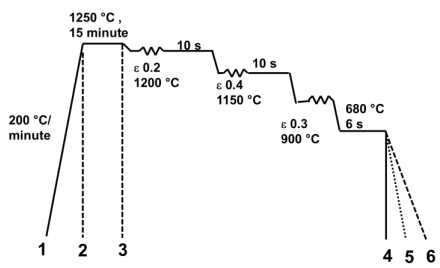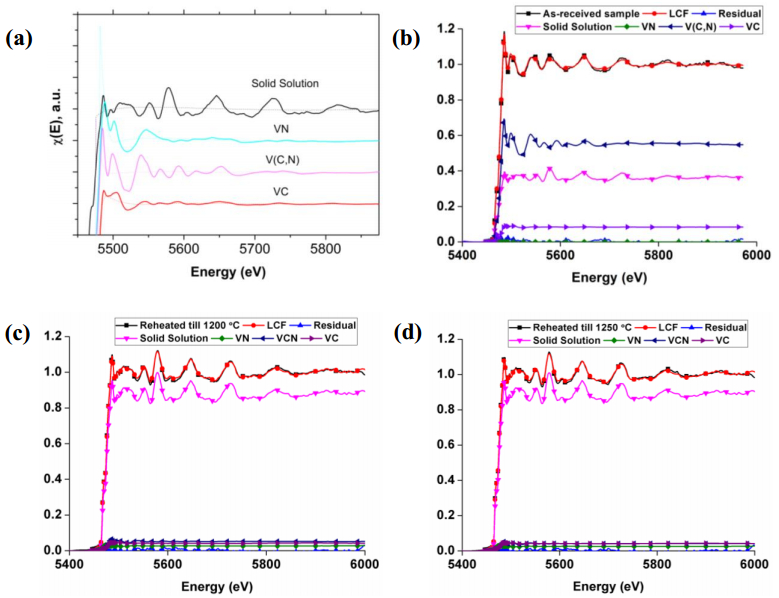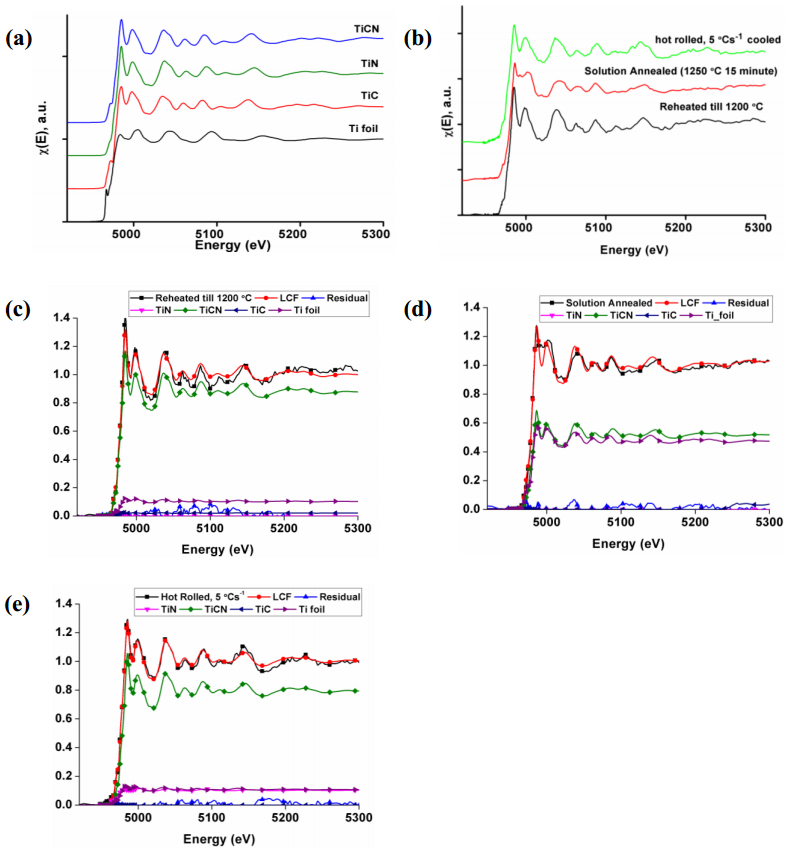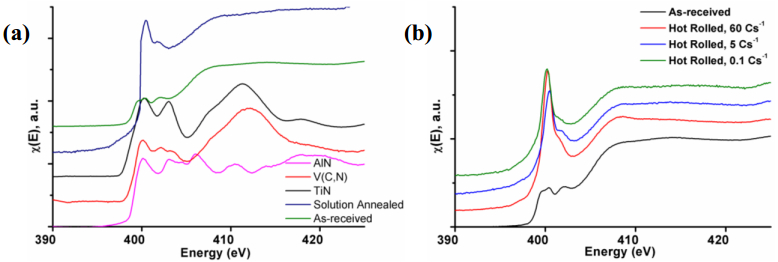1. Introduction
The precipitation and dissolution behavior of microalloying elements in steel is rather complex. Some result in large precipitation hardening effect while some can withstand higher temperature and are beneficial in grain boundary pinning to inhibit the austenite grain growth. The potential elements for the precipitation hardening have to be dissolved into the solid solution during the reheating process so that they are available for the precipitation during or after the thermomechanical process. These elements are such as vanadium and niobium. The selected high strength low alloyed (HSLA) steel contains vanadium for the precipitation hardening with titanium to assist austenite grain refinement during reheating. Niobium is, on the other hand, well-known to increase the strength of steel by retarding the recrystallisation in austenite and hence results in severe deformed austenite and consequently refines the ferrite grain size [1].
The reheating process before the hot rolling as well as other hot forming process is actually the only step which requires thermal energy. The topic draws attention from scientists for its optimisation [2,3,4]. The reheating process takes a few hours in HSLA and up to twice of that for carbon steel to ensure the complete dissolution of the microalloying elements for the precipitation hardening. If the dissolution of necessary strengthening alloying elements during the reheating process can be confirmed not to be the rate determining step, the reheating time can be adjusted shorter only according to the heat transfer analysis and thus can save considerable amount of energy. This work reveals how the dissolution kinetics of vanadium and titanium as well as some hints in the change in the atomic coordination can be investigated by XAS both quantitative and qualitatively.
The experimental investigation of the precipitating species must be in nanometer size range. Therefore, the transmission electron microscopy (TEM) with energy dispersive spectroscopy (EDS) is the most common characterisation technique for compositional and structural analysis. The small sampling volume, uncertainty in the accuracy and precision of EDS, as well as the difficulties in sample preparation are unattractive factors. X-ray absorption spectroscopy (XAS) is an alternative characterisation technique which can be used to identify and quantify the chemical species in metal although shown by only a few papers [5,6,7]. The XAS spectra are composed of two ranges: X-rays absorption near edge structure (XANES) and extended X-rays absorption fine structure (EXAFS) as shown in Figure 1. XANES is formed by the transition of core electrons to the non-bound levels, resulting in abrupt energy absorption and sharp rise in the spectra. EXAFS is formed by the emitting photoelectron, which results in the scattering effect with the nearest neighbours and next-nearest neighbours. Because of the advantages of synchrotron radiation, the XAS experiment obtains high signal-to-noise data in a reasonable measuring time. The very low concentration in order of 0.01 mass% in microalloyed steel can be investigated well according to the high flux intensity.
2. Materials and Method
An ingot of 80 kg with the listed composition in Table 1 was cast and cooled down to room temperature and was pre-deformed and reheated repeatedly in an open die forge in order to destroy the cast structure and the segregation as much as possible. A sample was cut from the pre-deformed bar and called as-received sample. Other samples were machined into a rectangular shape with dimensions of 7 × 10 × 1 mm3 to simulate the reheating in a deformation dilatometer Bähr DIL 805 A/D to ensure extremely high cooling rate by quenching in helium. The development of the precipitation during and after the hot rolling process was simulated in cylindrical samples with a diameter of 5 mm and a length of 10 mm in the same dilatometer. The thermomechanical cycle and the status of different samples are drawn and summed up in Figure 2 and Table 2. The samples were then carried out for metallography by light optical microscopy (LOM) and their precipitates were extracted into carbon replicas and investigated by scanning transmission electron microscopy (STEM). Extra duplicate samples were made for the investigation in XAS. These samples were polished flat until no clear roughness can be seen.
Table 1. The chemical composition of the simulated steel, all in mass%.
| Material Name |
C |
Si |
Mn |
P |
S |
Cr |
Mo |
Al |
Ti |
V |
N |
| V-HSLA |
0.070 |
0.05 |
0.98 |
0.0055 |
0.0033 |
0.50 |
0.010 |
0.0334 |
0.011 |
0.10 |
0.0240 |
Table 2. The samples taken from different points the in the thermomechanical cycles indicated in Figure 2.
| Point |
Sample name |
Treatments |
| 1 |
As-received |
Starting point of all the processes in this work |
| 2 |
Reheated sample to 1200 and 1250 ℃ |
Reheated to 1200 and 1250 ℃ and quenched immediately |
| 3 |
Solution annealed |
Reheated to 1250 ℃, held for 15 minutes and quenched |
| 4 |
Hot rolled with 60 ℃/s |
Point 3, followed by simulated hot rolling and a linear cooling at 60 ℃/s |
| 5 |
Hot rolled with 5 ℃/s |
Point 3, followed by simulated hot rolling and a linear cooling at 5 ℃/s |
| 6 |
Hot rolled with 0.1 ℃/s |
Point 3, followed by simulated hot rolling and a linear cooling at 0.1 ℃/s |
All the XAS experiments were carried out at Siam Photon Laboratory (SPL) in the Synchrotron Light Research Institute (SLRI), Nakhon Rachasima, Thailand. The EXAFS spectra at vanadium and titanium K-edge were recorded at beamline BL8 [8] while XANES spectra at nitrogen K-edge were done at BL3.2a for a lower energy range. The beam current was 146–60 mA during all the measurement, while the electron energy was 1.2 GeV. The vanadium and titanium K-edge XAS spectra were recorded from metal samples in the X-ray fluorescence mode using a 13-elements germanium detector with the energy resolution (ΔE/E) of 3 × 10−4. All samples were set in an identical position where the angle between sample surface, incident X-ray and detector was 45 degree. The beam size was 1 × 20 mm2 and was cut down for some samples. The powder standard compounds were prepared in a thin layer film and measured in transmission mode with a 40-cm long ionisation chamber containing a mixture of argon and helium with a pressure of 104 mbar. The energy range of the scans was from 5400 to 6000 eV and 4900 to 5400 eV for vanadium K-edge and titanium K-edge respectively. Twelves scans for vanadium and five scans for titanium were recorded to reduce the noise. The standard compounds for the XAS measurement of vanadium were VC, VN and V(C, N). The first two are from ESPI metals with a purity higher than 99% while the latter one was taken from the commercial Nitrovan®, which is used for alloying vanadium-containing steel. Titanium compounds are TiCN, TiC and TiN from Sigma Aldrich® with a purity higher than 98.00%. All powdered compounds were manually finely ground before putting in the Kapton tape frames and measured in the transmission mode. The solution annealed sample at point 3 in Figure 2 and Table 2 was also taken as a standard sample measured in fluorescent mode.
The XANES measurements of nitrogen were carried out on beamline BL3.2a [9] at the SLRI, Thailand. The XANES spectra were measured in the total electron yield (TEY) and the total fluorescence yield (TFY) modes. It is the case for AlN that only TFY could be used due to its very low conductivity. A picoammeter and multichannel (MCP) detector was used to record the signal for TEY and TFY modes respectively. Each data point was obtained from the averaging the measurement in 10 s period. The spectra were measured at an angle 20° to the surface. The energy resolution ΔE for the 1200 line/mm grating employed for nitrogen K-edge (with a 100 µm exit slit) was 0.4 eV. The N K-edge spectra were measured in the energy range of 385 to 425 eV at an energy step of 0.1 eV. Standard compounds for nitrogen XANES analysis were Nitrovan®, TiN, AlN. The AlN was also from Sigma Aldrich® with a purity higher than 98.00%. All types were compressed into a small tablet with a diameter of 5 mm with a thickness of 1 mm.
The obtained spectra were processed in the Athena software for the background subtraction, data normalisation, and the Linear Combination Fit (LCF) analysis [10]. The LCF was carried out in the normalised spectra for quantifying the amount of different forms of vanadium and titanium. The fit was carried out between −50 to +400 eV and −80 to +400 eV from the vanadium and titanium K-edges respectively.
3. Results and Discussion
The microstructure of the as-received sample before the reheating process investigated by LOM is revealed in Figure 3a. Ferrite and pearlite with some trace of the former banded structure corresponds to the repeating processes of reheating and deformation in the laboratory cast ingot, followed by intermediate cooling rate. Figure 3b–3e were derived from STEM on the carbon replica samples of the precipitates in the as-received sample. Some precipitates are in cubic shape while some are round. The cubic shape is well-known to be TiN which can precipitate since during solidification or the reheating before the pre-deformation of the ingot [11,12]. Large precipitates were found by EDS to be mainly Ti-V(C, N) and AlN, some of which precipitate on their predecessor. Small particles were proven to be only Ti-V(C, N) while AlN has not been found but it can be due to the random EDS analysis on limited number of particles. Under the limit of EDS, whether Ti-V(C, N) is a pure nitride or carbonitride is impossible to determine as the carbon substrate always results in the characteristic X-ray peaks of carbon. Both cubic and round precipitates show the peaks of Ti and V according to the miscibility between titanium and vanadium proven by thermodynamics [11,12,13] as well as the possibility of precipitating on existing precipitates. Hence both titanium and vanadium content can be detected in the same measured spots. Nevertheless, the different shapes hint 2 groups: TiN and V(C, N) as found more clearly in the hot rolled state [14]. Note that the EDS peaks of copper appear due to copper grid supporting the tiny carbon replicas.
Figures 3f–3i reveal the precipitates found in the carbon replicas of the solution-annealed sample. No AlN has been detected from the random EDS investigation and only cubic precipitates with appear obviously in the micrograph, showing some amount of vanadium. This confirms that AlN and V(C, N) are dissolved after the solution annealing, which are beneficial for the selected alloying concept.
The solution annealed sample was taken as a V(C, N) free standard sample according to the results from STEM and EDS, hence taken as a standard form of vanadium in the solid solution like in a former work [14]. Its normalised EXAFS spectrum is compared with other compounds of vanadium, VC, VN and V(C, N) in Figure 4a. Clear differences in the spectrum can confirm the change of the coordination around the vanadium atom in the sample during the solution annealing treatment. The as-received and reheated samples can be quantified for the fraction of dissolved vanadium atoms, using the solid solution standard sample, combined with the other standards of vanadium compounds through the LCF as shown in Figure 4b–4d. The resulting fitting quality is listed in Table 3.
Table 3. The atomic fraction of vanadium in different forms analysed by XAS with LCF.
|
V in solid solution |
V(C, N) |
VC |
VN |
Sum |
R-value |
| As-received |
0.364 ± 0.010 |
0.553 ± 0.014 |
0.084 ± 0.022 |
0.000 ± 0.015 |
1.000 |
0.0010688 |
| Reheated sample to 1250 ℃, immediately quenched |
0.890 ±0.015 |
0.042 ± 0.010 |
0.043 ± 0.011 |
0.026 ± 0.005 |
1.001 |
0.0002679 |
| Reheated sample to 1200 ℃, immediately quenched |
0.878 ± 0.014 |
0.052 ± 0.009 |
0.042 ± 0.010 |
0.027 ± 0.004 |
0.999 |
0.0002667 |
We can conclude that the atomic fraction of vanadium atom increases from 0.364 in the as-received sample to larger than 0.87 as soon as the sample is reheated to 1200 ℃ and then immediately quenched. Reheating to a higher temperature at 1250 ℃ does not show much larger amount of the free vanadium atoms. All fittings show very high quality of fitting with R value smaller than 0.0011. This confirms the rapid dissolution of vanadium compared with niobium and titanium as investigated earlier by [15].
V(C, N) can be found to be the main precipitate species although the solubility product predicts that VN has higher affinity. This can be explained that the pre-deformation process of the ingot was very fast at high temperature but the ingot was cooled down very slowly at lower temperature, where V(C, N) is stable. The same has been found in the case of hot rolling in an earlier work [14].
The EXAFS spectra behind the titanium K-edge absorption in TiCN, TiN and TiC pure compounds show large similarity while that of a titanium foil containing pure titanium in hexagonal close-packed structure shows obvious differences. Some alteration of the spectra during reheating can be noticed in Figure 5b. The sample reheated to 1200 ℃ represents the starting point during reheating. The solution annealed sample reveals its spectrum when the sample is reheated to a higher temperature of 1250 ℃ for 15 minutes and is taken as the final state of reheating. The hot rolled sample, cooled at 5 ℃/s shows the final state of titanium after the processing.
With awareness of some inaccuracy due to the difficulties in procuring a standard sample of titanium in iron solid solution, the LCF method has been applied again to the available standards, TiC, TiN, TiCN and titanium foil, and the fitting result is nevertheless reasonably good. The details of the fitting results are listed in Table 4 showing the sums deviating from 1.000, probably due to the incomplete set of standards. However, it can be seen that the TiN specie dominates in all samples. After the reheating at 1250 ℃ for 15 minutes, its amount drops a little and increases again after hot rolling and cooling. This confirms that the reheating at 1250 ℃ cannot completely dissolve TiN and thus not possible to become a standard sample accordingly.
Table 4. The atomic fraction of titanium in different forms analysed by XAS with LCF.
| Sample |
Ti foil |
TiC |
TiN |
TiCN |
Sum |
R-Value |
| Hot rolled sample cooled at 5 ℃/s |
0.013 ± 0.000 |
0.106 ± 0.035 |
0.760 ± 0.000 |
0.000 ± 0.050 |
0.879 |
0.0022153 |
| Reheated sample to 1200 ℃, immediately quenched |
0.000 ± 0.031 |
0.103 ± 0.060 |
0.883 ± 0.069 |
0.020 ± 0.086 |
1.006 |
0.0042386 |
| Reheated sample to 1250 ℃, held for 15 minutes (Solution annealed for vanadium) |
0.000 ± 0.026 |
0.478 ± 0.007 |
0.521 ± 0.039 |
0.037 ± 0.007 |
1.036 |
0.0038321 |
The XANES spectra at nitrogen K-edge are plotted in Figure 6a and 6b, with a fixed distance between each spectrum. In one plot the as-received sample is compared with the available standards of nitrogen containing compounds. All are in powdered form and therefore by transmission mode except the solution annealed sample used earlier for the vanadium and titanium spectra, which was measured in fluorescent mode. The other plot shows the as-received sample with different samples undergone the reheating period at 1250 ℃ with different final thermomechanical paths. Only one scan per each sample was enough to show smooth spectra.
Before the quantitative analysis has been made in this work, it can be seen clearly that the sample before and after the reheating process has obvious difference. This could give a guidance about the alteration in the bonding between the central nitrogen and the microalloying elements, i.e., vanadium, titanium and aluminium. The process after the reheating period such as deformation and slower cooling rate does not result in any noticeable difference in the spectra. It can imply that the main change in the former bonding between nitrogen and microalloying elements takes place during this reheating period. Such qualitative analysis of nitrogen K-edge XANES is well-known in other sciences [16].
By LCF the hot rolled sample cooled at 5 ℃/s shows higher than 90% similarity to the solution annealed sample in the XANES region. It has to be noted again that not all possible compound standards were available. It might not be possible to dissolve all nitrogen and store in the solid solution by quenching and hence a standard sample with nitrogen in the solid solution cannot be made. An unknown issue made unclear absorption edge in the spectrum of the VN powder. The ageing kinetics of nitrogen has not been controlled and should be considered in the next work. Consequently, different forms of FeN should be procured.
4. Conclusion
The alloying concept with vanadium allows rapid dissolution during the reheating process that the vanadium is ensured to have efficient precipitation during and after the hot forming process. The vanadium K-edge EXAFS analysis can yield the relative kinetics of the dissolution of vanadium by means of the linear combination fit. It shows only the trace of vanadium carbonitride only after short reheating time. Titanium, on the other hand, remains mostly undissolved as revealed by the LCF. Due to the difficulties in its dissolution it is also not straightforward to prepare a standard sample of titanium in the solid solution of iron like in the case of vanadium.
Nitrogen K-edge XANES spectra show more challenges in the speciation of the compounds and precipitates due to several different possible species. Nevertheless obvious differences between the as-received sample before reheating and those after reheating as well as those undergone deformation and cooling appear in the spectra. This can attribute to the dissolution and precipitation of nitrogen during the reheating.
All in all, the XAS proves to be an efficient way to characterise the precipitation and dissolution of the microalloying elements. Nevertheless pure substances of different forms of the investigated elements are necessary especially for the quantitative analysis. Incomplete variety of standard compounds related to all possible precipitate forms enables only qualitative analysis or some assumptions. More difficulties can be found in case of active elements which can form various types of compounds with several elements in the samples such as carbon and nitrogen.
Acknowledgements
This research was funded by King Mongkut's University of Technology North Bangkok (Contract no. KMUTNB-NRU-59-09). The former funding from the Exploratory Research Space @ RWTH Aachen University (ERS) has to be mentioned for the starting point of the research as well.
Conflict of Interest
All authors declare no conflicts of interest in this paper.









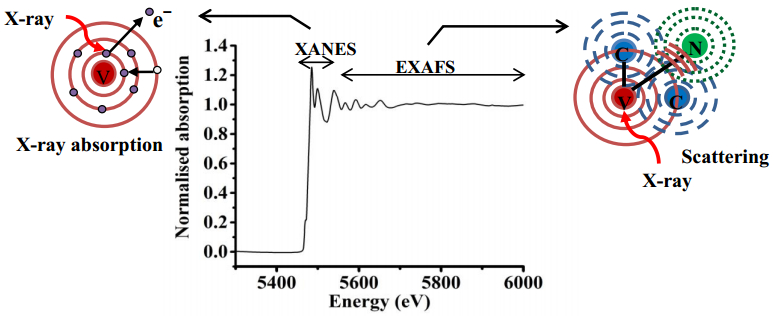
 DownLoad:
DownLoad: 